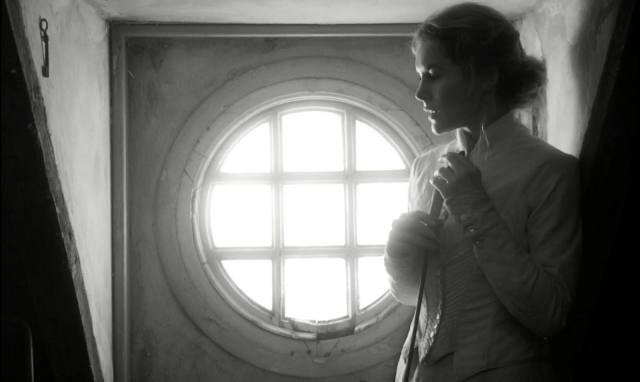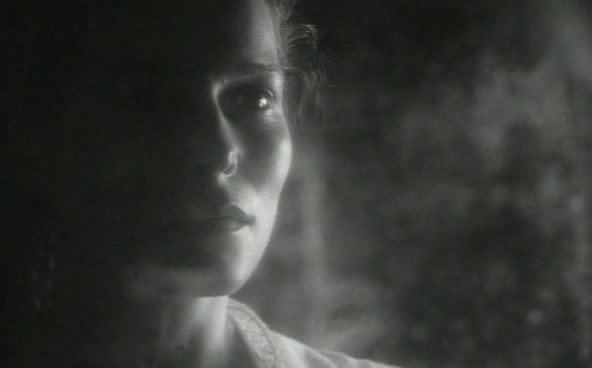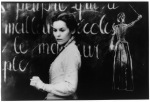
INSTITUTE BENJAMENTA
or This Dream People Call Human Life
Gottfried John / Alice Krige / Mark Rylance / Daniel Smith / Joseph Alessi / Jonathan Stone / Ceasar Sarachu / Peter Lovstrom / Uri Roodner / Based on the novel ‘Jakob von Gunten’ by Robert Walser / Art Direction Alison Riva / Costume Design Nicky Gillbrand / Production Design Jennifer Kernke / Editor Larry Sider / Original Soundtrack Lech Jankowski / Producer Karl Baumgartner / Directors The Quay Brothers
Duality is the key to the works of the Brothers Quay, their films can be viewed in two quite opposing, though equally legitimate ways. That is, as deeply profound pieces, with a haunting intensity of perception.. or a collection of disparate moments that appeal on a purely esoteric level. Either way, the result is beautiful and sublime. To be honest, on the whole I’ve never been all that keen on their stop-frame shorts, as blasphemous as that is to admit, given the brothers iconic status in the animation world.. but they’re just a little too pretentious for my liking. That brand of Eastern European animation was quite draining even in it’s original form, let alone in regurgitated homage. One imagines the younger Quay boys collecting milk-bottle tops, in mesmeric rhapsodies over spinning toys and purposefully breaking the keys on the family piano, just to delight in it’s jarring off-notes.. although in reality they were probably dissapointingly normal.

Institute Benjamenta uses some of the same imagery and stop-frame effects as their earlier short films, but better manages to achieve something more substantial and mature, hypnotic rather than monotonous. A steady rhythm pulses throughout weaving a dream-like sensation that both embraces and disturbs in equal fashion.

Based upon Robert Walser’s semi-autobiographical experiences attending a Berliner school for servents in 1905, ‘Benjamenta’ is as much a journey into the mind of the unstable Walser, as it is the Brother’s Quay. Much of Walser’s literary output was pieced together from arcane scrawlings and coded messages (known by his enthusiastic followers as ‘Bleistiftgebiet’ or ‘Microscripts’) put to paper during his long stays in the Waldou sanatorium. At the time regarded as mere ramblings, it wasn’t until the 1970’s that Walser became recognized as a key voice of Modernism, along with Bruno Schulz (‘Street of Crocodiles’ & ‘Sanatorium Under the Sign of the Hourglass’).

We enter the Institute with Gottfried John, who seeks to learn ‘the divine duty of the servant’, along with a band of oddball potential butlers and waiters. Headmistress to these submissives is Alice Krige (yes, ST:TNG’s Borg Queen) who positively vibrates like a tuning fork dressed in a pure white corset whilst clutching a quite worrying riding crop that appears to be made from a goat’s hoof. Krige floats about her scenes with a preternatural grace, small traces of ecstatic electricity emerging in flickers across her powerfully emotive features.. or are they merely blank? Curious how so many of the great cinematic performances are upon closer inspection so subtle as to be ghostly in terms of analysis..

Given the film’s clear associations with German Expressionist Cinema, the obvious parallel is with Pabst’s Diary of a Lost Girl, with it’s sado-masochistic-lesbian Fraulein holding sway over The Home for Lost Girls’. Whilst Pabst chose the Avant-garde dancer Valeska Gert for the role (probably the single most disturbing performance of the entire Silent period) dominating her female charges, here in contrast we have the strikingly beautiful Alice Krige (though no less elemental a force) controlling male supplicants somewhat complicit in their subordinacy to a dominatrix. Also add in for good measure, a dash or two of both the 1931 Maedchen in Uniform, and it’s 50’s remake with Romy Schneider.

Benjamenta is a prose piece that dwells in a continual dream-state, the world glimpsed giddily through an eternally smokey filter.. how do the Brothers Quay put it? Oh, yes, through ‘a dusty window pane.’ The lighting really is exquisite, treating Alice Krige like a flood-lit Louise Brooks, or a stoic Dietrich, whilst stepping into a Victorian box of curiosities. Showing a giddy subtlety that Pabst and Josef von Sternberg would have applauded enthusiastically.

‘I should never let myself be rescued.. nor shall I ever rescue anybody.’

“I am dying from the emptiness of cautious and clever people.”

‘The divine duty of servants..’

‘Sometimes more life dwells in the opening of a door than in a question. Past and future circle about us. Now we know more.. now we know less.’


“This is freedom,’ said the instructress, ‘it’s something very wintry, and cannot be borne for long. One must always keep moving, as we are doing here, one must dance in freedom. It is cold and beautiful. Never fall in love with it. That would only make you sad afterwards, for one can only be in the realm of freedom for a moment, no longer. Look how the wonderful track we are floating on is slowly melting away.. watch freedom dying, if you open your eyes…” (

“With all my ideas and follies I could one day found a corporate company for the propagation of beautiful but unreliable imaginings.” (

STILLS

~ Alice Krige (b. 28th Jun, 1954) Cape Province, South Africa ~






